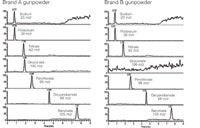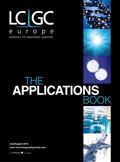Gunpowder Profiling for Brand Identification using HPLC–MS
The Application Notebook
Conclusively determine the make and manufacturer of gunpowders by characterizing their distinguishing ingredients.
Guifeng Jiang and Kathryn Preston, Thermo Fisher Scientific, San Jose, California, USA.
Introduction
Gunpowder can be characterized quickly for routine identification of its manufacturer and brand by employing high performance liquid chromatography with mass spectrometry (HPLC–MS). Highly polar compounds with low molecular weight commonly found in gunpowder particles, pellets and trace residue are easily separated for forensic analysis using a column consisting of fully porous graphite carbon particles and are detected using a sensitive, single quadrupole mass spectrometer through both positive and negative electrospray ionization (ESI) within a single chromatographic injection.
Experimental Conditions
Sample preparation
Trace amounts of muzzleloading black powders, 5.2 mg of Brand A and 3.0 mg of Brand B, were extracted in 1.0 mL of water for 10 min, filtered and diluted by a factor of 100.
Chromatographic conditions
A 5.0 µL injection was separated and detected using Thermo Scientific instruments including the Accela UHPLC system, Hypercarb 100 × 2.1 mm column with 5 µm particles and the MSQ Plus mass detector. A binary gradient of water and methanol with 1.0% formic acid at 300 µL/min separated the compounds within 9 min.
LC column: Hypercarb, 5 µm, 100 × 2.1 mm
Column temperature: Room temperature
Injection: 5 µL partial loop injection
Gradient: A: water (1.0% formic acid) B: methanol (1.0% formic acid)
Flow rate: 300 µL/min
Mass Spectrometer Conditions
Channels of positive and negative polarity full scan mass spectra were acquired, each using an ESI voltage of 3.5 kV and a probe temperature of 550 °C.
Ionization: Electrospray (ESI)
Polarity: Positive and negative
Probe temperature: 550 °C
ESI voltage: 3.5 kV
Results
Comparing extracted mass chromatograms of seven profiled gunpowder compounds (Figure 1) clearly indicates that the presence or absence of gluconic acid in Brand A and Brand B respectively and provides conclusive differentiation between the two brands. The Accela UHPLC system with Hypercarb column provides excellent separation of the highly polar compounds commonly found in gunpowder; and, the MSQ Plus mass detector provides highly sensitive detection of extremely low molecule weight ions.

Figure 1: Extracted mass chromatograms of profiled gunpowder compounds demonstrating conclusive differentiation between Brand A and Brand B muzzleloading black powders based upon the presence or absence of gluconate, respectively.
Although most profiled compounds are identified by extracted mass chromatograms of their molecular ions, dicyandiamide and benzoic acid are ionized and detected as (M-NH2)+ and (M-OH)+ , respectively.
Conclusion
This work shows that profiling of gunpowder using HPLC–MS can facilitate quick and routine determination of manufacturer and brand. Conclusive identification of gunpowder with HPLC–MS is accomplished by using a column packed with porous graphite carbon particles for efficient separation of highly polar gunpowder compounds and by using a sensitive, single quadrupole mass spectrometer for easy detection of extremely low molecular weight ions.
Legal Notices
©2009 Thermo Fisher Scientific Inc. All rights reserved. All trademarks are the property of Thermo Fisher Scientific Inc. and its subsidiaries. This information is presented as an example of the capabilities of Thermo Fisher Scientific Inc. products. It is not intended to encourage use of these products in any manners that might infringe the intellectual property rights of others. Specifications, terms and pricing are subject to change. Not all products are available in all countries. Please consult your local sales representative for details.
View additional Thermo Scientific LC–MS application notes at: www.thermo.com/appnotes

Thermo Fisher Scientific Inc.
355 River Oaks Parkway, San Jose, California 95134, USA
tel. +1 561 688 8900 fax +1 608 273 6880
E-mail: analyze@thermo.com
Website: www.thermo.com

A Guide to (U)HPLC Column Selection for Protein Analysis
April 16th 2025Analytical scientists are faced with the task of finding the right column from an almost unmanageable range of products. This paper focuses on columns that enable protein analysis under native conditions through size exclusion, hydrophobic interaction, and ion exchange chromatography. It will highlight the different column characteristics—pore size, particle size, base matrices, column dimensions, ligands—and which questions will help decide which columns to use.
The Benefits of Custom Bonded Silica
April 1st 2025Not all chromatography resins are created equal. Off-the-shelf chromatography resins might not always meet the rigorous purification requirements of biopharmaceutical manufacturing. Custom bonded silica from Grace can address a wide range of separation challenges, leading to real performance improvements. Discover more about the latest innovations in chromatography silica from Grace, including VYDAC® and DAVISIL®.
5 Things to Consider When Selecting a Chromatography Silica
April 1st 2025Particularly in the pharmaceutical industry, drug purity isn’t just a goal – it’s essential for achieving safety, stability and efficacy. However, purification is easier said than done, especially with challenging molecules like DNA and RNA “oligonucleotides,” due in large part to their diversity and the range of impurities that can be generated during production. Enter DAVISIL® chromatographic silica, with a wide range of pore diameters and particle sizes to meet your specific application, performance and sustainability requirements. Before you choose the chromatography resin for your next purification application, take a look at these 5 considerations.
Automating Protein Purification: Efficiency, Yield, and Reproducibility
March 27th 2025Recent advancements in automated protein purification stress the importance of efficiency, scalability, and yield consistency. This eBook compares different purification platforms, highlighting their impact on downstream applications and demonstrating how automation enhances throughput and process control.














